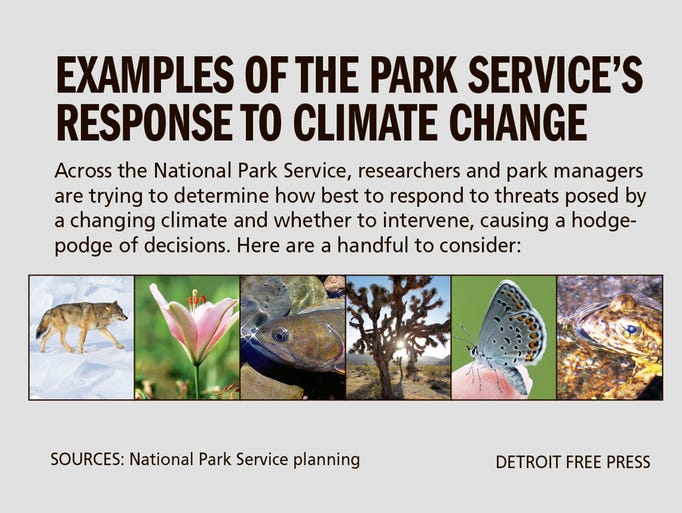Todd Spangler, Detroit Free Press
WASHINGTON — From new vehicle fuel standards and higher renewable energy targets to controversial plans to limit greenhouse gas emissions on coal-fired power plants, the Obama administration — in its words — has been “leading global efforts to address the threat of climate change.”
Those sweeping efforts, however, have done nothing so far to save a small, dwindling, treasured pack of gray wolves on a remote Michigan island, presumably due federal protection as a threatened species and guaranteed sanctuary in a national park, but still facing short-term extinction largely because of a warmer climate that prevents the formation of natural ice bridges that once allowed mainland wolves to travel to the island and kept the population healthy.
Over the past few years, varied proposals have been floated and considered for saving the Isle Royale wolves: from taking no action and letting nature decide, to adding wolves to prevent inbreeding that can produce unhealthy pups, or culling a burgeoning moose herd — growing because of the steep drop in predator wolves — without adding wolves.
Wary of setting a precedent and aware of the threat posed by litigious wilderness groups urging a hands-off approach, the National Park Service this summer launched a $250,000 study to help decide the future of the island’s three remaining wolves. If all goes as planned, it could be done by late 2017.
But coming nearly five years after the Park Service was alerted to the dire prospects for the 16 or so wolves left then, and two years after park managers began asking geneticists how to respond, questions are being raised now as to whether the bureaucracy poses as much a threat to the wolves of Isle Royale as climate change does.
“The Park Service was slow in initiating this process, there’s no question about it,” said U.S. Sen. Gary Peters, D-Mich., who has argued the new study could easily outlast the pack and has urged NPS Director Jonathan Jarvis to speed up the process to no avail. “We could have been wrapping it up by now.”
Peters wants “the best science” to dictate what happens. But others, including dozens of scientists and researchers, say the Park Service already has all the data it needs to add a few wolves before the pack is lost entirely. Already, many say, the island’s ecosystem is being ravaged without a top predator to cull the growing moose herd. If the wolves are lost, the damage to forestation could be irreparable.
“Wolves would restore balance to the system, and their numbers on Isle Royale should be augmented now,” 47 top conservation scientists wrote Jarvis last month, noting that moose numbers are exploding. “Delays in acting will only worsen the situation.”
Isle Royale’s superintendent, Phyllis Green, said there are many more considerations to be made, however, before moving on any plan regarding the wolves, the island and climate change. And they include the same vexing questions being asked across the Park Service’s hundreds of sites: Those questions range from whether the reintroduction or protection of a species could violate specific federal laws, to the Park Service’s chances of success, and whether such actions will provide for a sustainable species if, as expected, temperatures keep climbing.
As Green noted, her park’s most recent climate report indicated that moose on the island — the wolves’ main source of food — may not even survive the next 50 years.
“We’re just at the beginning of deciding what species we can make a significant impact on as climate changes roll through these national parks,” said Green, from her office on the Keweenaw Peninsula just a few days after closing down the uninhabited 45-mile-long island some 55 miles away across Lake Superior for the winter. “It’s a question we’re going to face time and time again.”
“I know people want us to rush through things,” she said. “It’s just not going to happen.”
Don’t try to do the impossible
In many ways, Isle Royale is unique. It’s the least-visited park in the lower 48 states. It’s closed six months of the year. Protected from hunting and logging, its wolf pack and moose have been the subject of a 57-year-long ecological study, the longest-continuous predator-prey research on record and one that has produced insights into topics as far afield as arthritis and air pollution.
But the threat posed by climate change — on Isle Royale, it’s the loss of consistent winter ice cover on the lake allowing mainland wolves to migrate to the island to lessen inbreeding — is being felt across the National Park system. So far, it has met with varied responses.
For instance, at Glacier National Park in Montana, rangers are moving threatened bull trout to higher elevations, in part, because those waters are less likely to be affected by warming. And at two parks in Hawaii, officials are supplementing rare plants with greenhouse-grown seedlings in hopes that a larger population will have a better chance to survive in their native habitat.
But at Joshua Tree National Park in California, officials suspended work on a plan that may have addressed the threat posed to the park’s namesake tree and acknowledge they are at nature’s mercy given the mammoth task of irrigating a park the size of Rhode Island. At Indiana Dunes National Lakeshore, endangered butterflies along Lake Michigan disappeared in 2015 after years of decline.
Park Service managers, said Gregor Schuurman, an NPS climate change ecologist, have wide latitude in determining appropriate responses to threats but are expected to take into account many factors, including whether a species faces total extinction in its native habitat — such as with the Hawaiian plants — or whether the climate has changed so drastically that reintroducing them, as may be the case at Indiana Dunes, makes little sense.
“A (park) manager is expected to act on the best available science,” he said. “They’re not expected to do what is impossible or unfeasible,” he said.
Let nature decide
Guiding those decentralized decisions are agency policies, guidelines and federal legislation that can often seem contradictory.
For instance, the U.S. Fish and Wildlife Service has primary responsibility for protecting gray wolves in the upper Midwest. But it has never considered Isle Royale’s population to be part of wolf recovery efforts because its population is so isolated. Fish and Wildlife wants wolves in the Great Lakes states taken off the endangered species list anyway, believing they’ve recovered.
Meanwhile, the Park Service’s own code says its mission is “to conserve … wildlife and to provide for the enjoyment of those resources in a manner that will leave them unimpaired,” which could argue for intervention. But the Wilderness Act, which applies to Isle Royale as a designated wilderness, says lands are to remain “untrammeled … with the imprint of man’s work substantially unnoticeable.”
Groups, including Wilderness Watch — which over the years has had several court victories forcing federal agencies to strictly enforce the Wilderness Act — say those edicts don’t envision reintroductions like that being talked about with wolves on Isle Royale.
“Doing so would be a direct manipulation of the wolf population on the island and we believe the Wilderness Act calls for us not to do those kind of manipulations,” said Kevin Proescholdt, the group’s conservation director. “We let nature decide, we don’t manipulate it.”
Indirect effects
But the wolves on Isle Royale have their supporters, too, many of whom argue that the Park Service can’t let the wolves disappear without permanently affecting the wilderness nature groups like Wilderness Watch want to protect.
“This was a park where the idea of letting nature do everything actually worked,” said Rolf Peterson, a research professor at Michigan Technological University in Houghton who, for 45 years, has been involved in the annual survey of Isle Royale’s wolves and their interaction with moose. “It wasn’t because of keeping hands off; it was because there were top carnivores (living there).”
Every year, Peterson and his colleague John Vucetich issue an annual report on the state of the wolves and moose on the island. Since the survey was started in the 1950s, the historical average has been between 18 and 27 wolves a year and 700 to 1,200 moose.
In 2011, when they noticed a steep decline in the wolf number, there were 16 and about 515 moose. This year, they estimated three wolves and 1,250 moose. Two wolves briefly visited the island during record winter ice cover the last two years but left. Where decades ago, ice bridges led to the island eight out of every 10 years, now it is approximately one in 10, leaving little chance to introduce genetic diversity into the pack.
“We reintroduced wolves to Yellowstone (National Park), but they’d say, in that case, we shot wolves, in this case the human factor is indirect,” said Vucetich. “What makes this so disturbing is that climate change is all about indirect effects.”
An emotional issue
Part of the concerns being raised by supporters involve a time line for study that Peterson — who says he could have put new wolves on the island a few years ago for as little as $5,000, a claim Green dismisses — and others openly describe as dithering.
Under law, federal agencies must take into account environmental impacts when making decisions. But, depending on the action being looked at, the time line can be shorter or longer.
Isle Royale is taking a longer, more thorough “environmental impact statement” route projected to last 2½ years. But they can take far longer. According to the National Association of Environmental Professionals’ data, final environmental impact statement reports by the National Park Service in 2012 and 2013 took, on average, more than six years to complete.
“It’s been talked about, much researched, much debated (but) we may not have wolves after this winter,” said Christine Goepfert, a manager for the National Parks Conservation Association, which advocates for the parks and wants wolves reintroduced to Isle Royale. “They’re dragging their feet because it’s an emotional issue. … In some ways they probably want to avoid making a decision.”
Green, the park superintendent, said using the more thorough EIS process “fits,” given the level of controversy. And there is a lot to be done: Each of the proposed options — from taking no action to adding wolves or culling the moose herd without adding wolves — must be thoroughly vetted. The key, she said, will be deciding what is best for the whole island and its food chain.
Simply reintroducing a handful of wolves — which was also done decades ago, with limited success — may not work, she said, which is why that option requires research on everything from the genetic makeup of the would-be additions to how many would be needed and how to handle and deploy them. It would probably cost at least $100,000 she said.
Green said that even if wolves are lost to the island, they could still be reintroduced later, but Vucetich said the damage moose could do to the forest in that time could be so vast that it would no longer support them in the long term. And no moose, no wolves.
But even without climate change, island ecology is notoriously fragile. The number of wolves and moose on Isle Royale have varied widely since both reached the island within the last 100 years. And if the Park Service is going to restore species impacted by human actions, why stop at wolves? Lynx and caribou were trapped and hunted out of existence on the island decades ago. A cold-water fish called cisco just recently disappeared from the island
“If you’re going to make a national park into an ark,” Green asked, “which species are invited on? Which aren’t?”
“It’s crystal balls. It’s probabilities. It’s uncertain,” she said. “It’s making a value judgment that trades off between policies, and the Park Service never trades off between policies lightly.”


